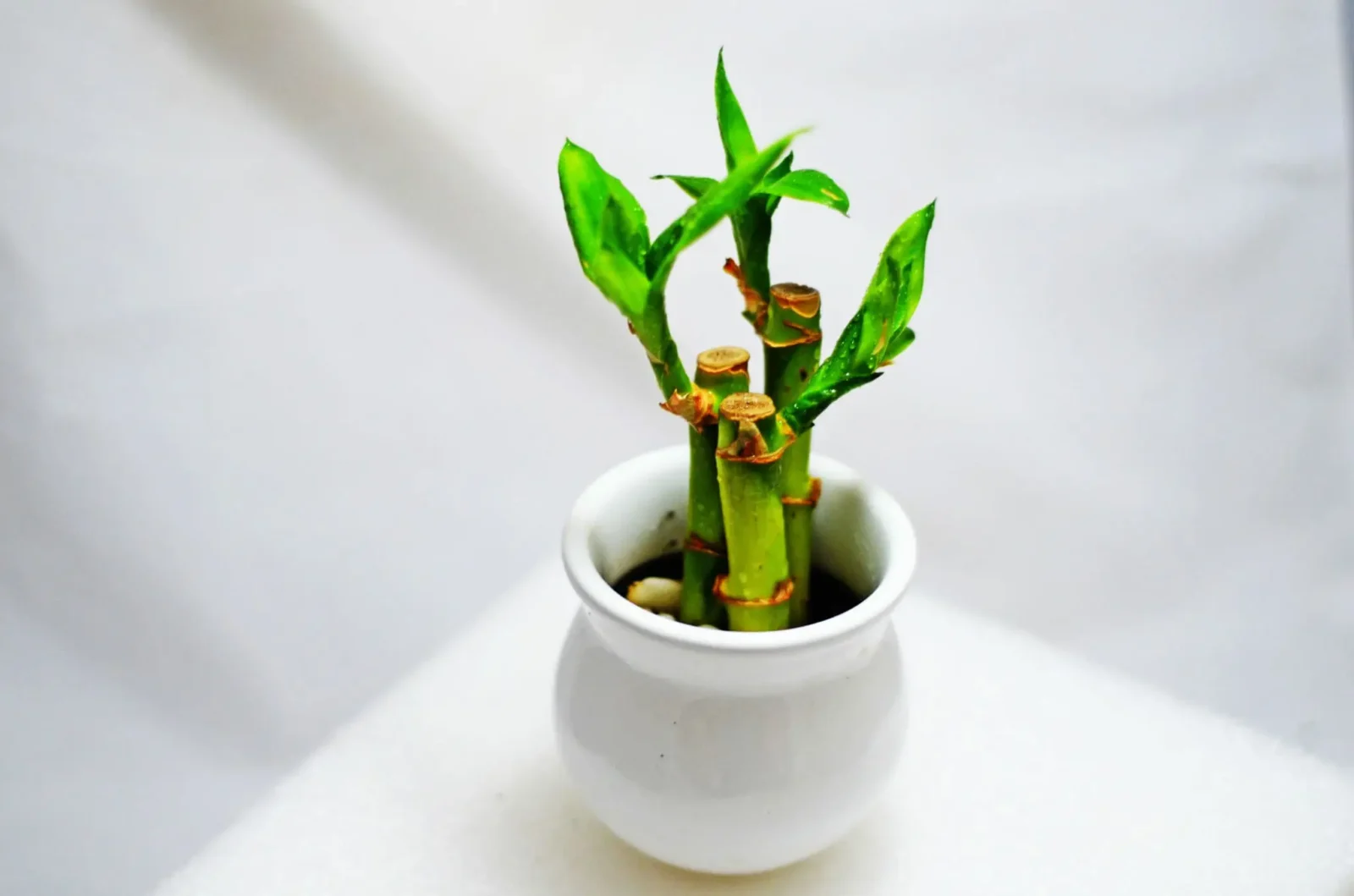Lucky Bamboo, an enigma of luck and beauty, captivates hearts with its slender green stalks and cultural mystique. In this exploration, we delve into the diverse types, the art of cultivation, and the intricate role it plays in Feng Shui.
Introduction
Mystique of Lucky Bamboo
Lucky Bamboo, scientifically known as Dracaena Sanderiana or Dracaena Braunii, stands as a beacon of prosperity and joy. Contrary to its name, it’s not a bamboo but a member of the lily family, gracing homes and events with its elegance.
Tapestry of Cultural Traditions
Originating from Southeast Asia, Lucky Bamboo carries a rich cultural heritage, especially prominent in Chinese traditions. It is a symbol of longevity, happiness, and positive energy, making it a revered gift for various occasions.
Quick Overview
| Common Name | Lucky Bamboo, Friendship Bamboo, Ribbon Plant |
| Botanical Name | Dracaena Sanderiana |
| Sun Exposure | Partial Shade |
| Soil Type | Water or Moist But Well-Drained Soil |
| Soil pH | Acidic |
| Family | Asparagaceae |
| Mature Size | Up to 1–5 Ft. Tall, 1–2 Ft. Wide (In) |
| Plant Type | Perennial Shrub |
| Bloom Time | Fall, Winter |
| Flower Color | White |
| Native Area | Africa |
| Toxicity | Toxic to Animals |
Benefits of Lucky Bamboo
Lucky Bamboo, scientifically termed as Dracaena Sanderiana, boasts an array of advantages, rendering it a favored choice for both residential and office spaces. Here’s a succinct overview of its unique benefits:
- Air Purity Enhancement:
- Lucky Bamboo stands out for its exceptional ability to purify indoor air, promoting an environment conducive to well-being.
- Minimal Maintenance Requirements:
- Embodying resilience and simplicity in care, Lucky Bamboo caters to individuals seeking a plant that demands minimal attention and effort.
- Feng Shui Positivity:
- Placing Lucky Bamboo strategically is believed to usher in positive energy and good fortune according to Feng Shui principles.
- Symbolic Importance:
- Beyond its aesthetic allure, Lucky Bamboo holds profound symbolic meanings, embodying notions of good fortune, enduring life, and joy.
- Versatile Decorative Element:
- The supple nature of its stalks allows for imaginative arrangements, introducing an element of grace and sophistication to any setting.
- Sentiments of Prosperity in Gifting:
- The act of gifting Lucky Bamboo becomes a thoughtful gesture, conveying positive vibes and wishes of prosperity to the recipient.
- Adaptability Across Light Conditions:
- Lucky Bamboo thrives in diverse lighting scenarios, adapting seamlessly to different indoor settings and lighting intensities.
- Augmented Aesthetic Appeal:
- The inclusion of Lucky Bamboo elevates the visual appeal of a space, fostering a serene and aesthetically pleasing atmosphere.
- Cultural Reverence:
- Deeply embedded in Asian traditions, Lucky Bamboo transcends its botanical status, embodying cultural reverence and connecting individuals to ancient beliefs.
- Stress Alleviation:
- Embracing indoor plants like Lucky Bamboo contributes to stress reduction and an overall improvement in the well-being of individuals.
In essence, Lucky Bamboo surpasses mere ornamental value, acting as a bearer of positivity, aesthetics, and a touch of nature, making it a remarkable addition to any environment.
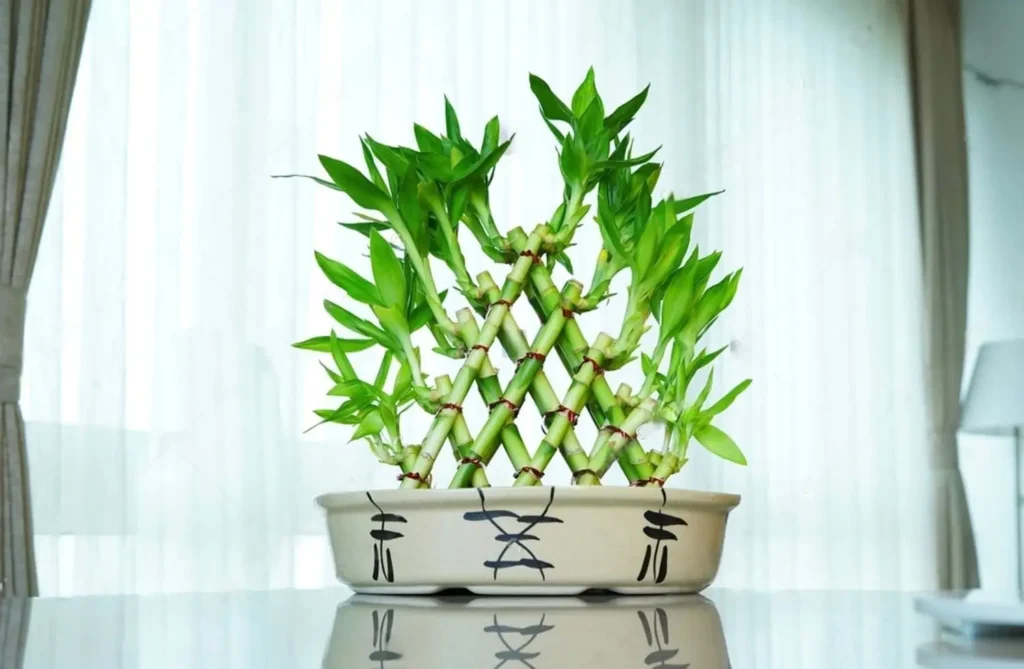
Read Me – Living Stones: The Ultimate Care And Growing Guide
Caring: Nurturing for Your Lucky Bamboo
Caring for Lucky Bamboo is a rewarding and straightforward process that, when done right, ensures the health and longevity of this symbol of luck and positive energy. Below are essential care guidelines to help you nurture your Lucky Bamboo and watch it thrive.
Lighting Requirements:
- Lucky Bamboo prefers indirect sunlight, making it suitable for spaces with filtered or shaded light. While it can tolerate low light conditions, exposing it to some filtered sunlight enhances its vibrancy.
Watering Tips:
- Water sparingly and with precision. Allow the top inch of the soil to dry out before watering again. Overwatering is a common issue, so it’s crucial to strike a balance. Ensure that the roots are not sitting in water to prevent overhydration and root rot.
Soil Considerations:
- Opt for a well-draining soil mix, preferably pebble-based. This type of soil provides stability to the plant and prevents waterlogging, ensuring optimal conditions for Lucky Bamboo’s growth.
Taking these steps in caring for your Lucky Bamboo will contribute to a thriving and vibrant plant. Remember, understanding its specific needs, particularly in terms of light and water, is key to maintaining a healthy and beautiful Lucky Bamboo.
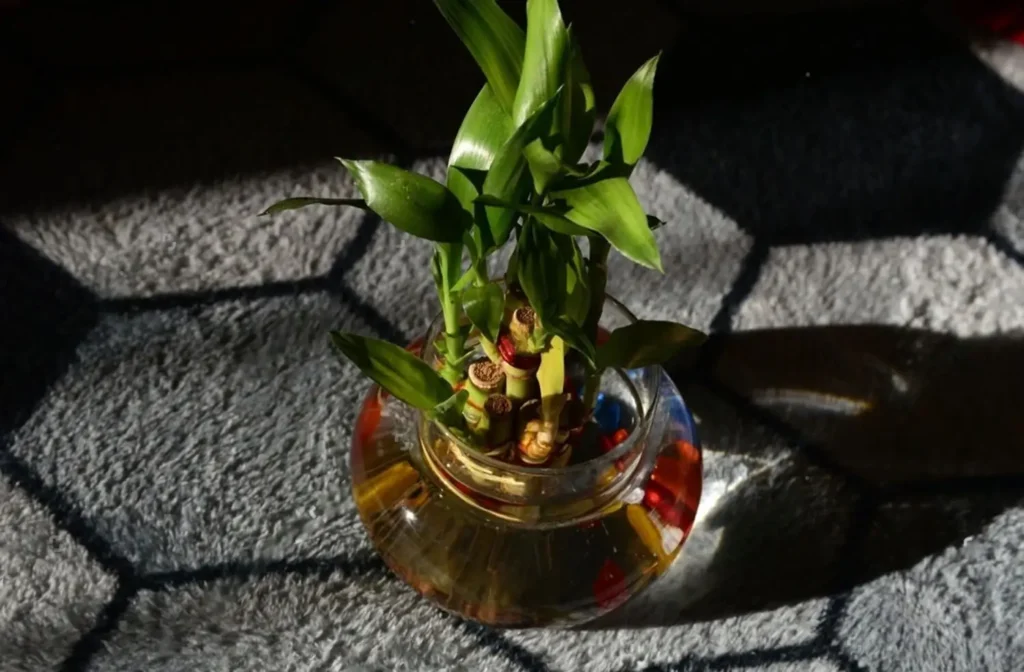
Propagating Lucky Bamboo: A Green Endeavor
Propagating Lucky Bamboo is a rewarding and green venture that allows you to expand your collection and share the positive energy of this symbol of luck with others. Whether you want to create new arrangements, gift plants to friends, or simply nurture the growth of your existing Lucky Bamboo, understanding the art of propagation is essential.
Selecting Healthy Stalks
The first step in propagating Lucky Bamboo is choosing healthy stalks. Look for stems that are disease-free, vibrant, and free from any signs of distress. Healthy stalks ensure a successful propagation process and contribute to the longevity of the new plants.
Cutting and Trimming
Once you’ve identified suitable stalks, use clean and sharp scissors or pruning shears to cut the stems. The cutting should be done at a 45-degree angle, ensuring a clean and precise cut. Additionally, trim excess leaves and roots to encourage a healthy and balanced growth in the new plants.
Rooting in Water
The next phase involves rooting the cut stems in water. Place the cut end of the stalks in a vase filled with distilled or filtered water. Change the water on a weekly basis to maintain cleanliness and provide a conducive environment for root development. Monitor the process as roots typically start to emerge within a few weeks.
Transplanting into Soil
Once the roots of the Lucky Bamboo cuttings have reached a length of 2-3 inches, it’s time to transplant them into soil. Choose a well-draining soil mix, preferably one that includes pebbles or perlite. Create a hole in the soil and gently place the rooted end of the cutting into it. Press the soil around the stem to provide stability and water lightly.
Caring for Young Plants
After transplanting, care for the young Lucky Bamboo plants similarly to mature ones. Ensure they receive indirect sunlight, maintain the right balance of water, and avoid overwatering to prevent root rot. As the new plants establish themselves, you’ll witness the growth of vibrant leaves and the characteristic elegance of Lucky Bamboo.
Creative Possibilities
Propagation not only multiplies your Lucky Bamboo collection but also opens up creative possibilities. Experiment with different arrangements, combining various stalk lengths and shapes to create visually appealing displays. Consider gifting propagated Lucky Bamboo to friends and family, sharing the positive energy associated with this resilient and auspicious plant.
Conclusion
Propagating Lucky Bamboo is a green endeavor that adds both beauty and positive energy to your surroundings. By carefully selecting healthy stalks, cutting and trimming with precision, and providing the right conditions for rooting and growth, you can enjoy the satisfaction of nurturing new life. Embrace the creative possibilities that propagation offers and share the luck and beauty of Lucky Bamboo with those around you.
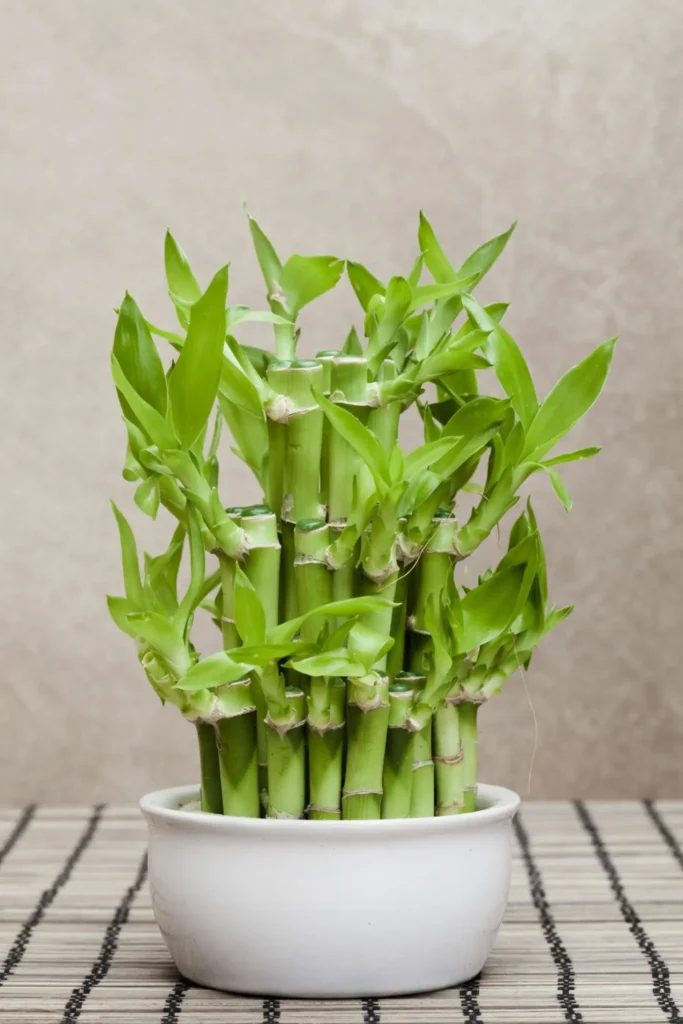
Potting & Repotting Lucky Bamboo: Nurturing Growth
Potting and repotting are critical aspects of caring for Lucky Bamboo, ensuring the plant thrives and continues to bring luck and beauty to your space. Let’s delve into the intricacies of potting and repotting this symbol of prosperity.
Potting Procedure:
Choosing the Right Pot:
Selecting an appropriate pot is the first step in fostering healthy growth for your Lucky Bamboo. Here are some guidelines:
- Size Matters: Opt for a pot that is 2 inches larger in diameter than the current pot. This allows ample space for the roots to expand without being constricted.
- Drainage Holes: Ensure the chosen pot has drainage holes. Proper drainage is crucial to prevent waterlogging, which can lead to root rot.
Potting Process:
Once you have the right pot, follow these steps to ensure a smooth and successful potting process:
- Prepare the Soil Mix: Use a well-draining soil mix with a base of pebbles. This promotes stability, prevents overwatering, and supports the overall health of your Lucky Bamboo.
- Positioning the Plant: Place the Lucky Bamboo in the center of the pot, ensuring the roots are evenly spread. This encourages balanced growth and stability.
- Adding Soil: Gently fill the pot with the prepared soil mix, covering the roots and stabilizing the plant. Be cautious not to bury the plant too deep; the roots should be just below the surface.
- Watering: Water the plant lightly after potting. Ensure the soil is evenly moist but not waterlogged.
Repotting Guidelines:
Repotting is a natural part of Lucky Bamboo care and is necessary every two years or when the plant outgrows its current container. Here’s a step-by-step guide for successful repotting:
- Assessing the Plant: Before repotting, examine the Lucky Bamboo for signs of outgrowing its current pot. Look for crowded roots, stunted growth, or roots emerging from the drainage holes.
- Choosing a New Pot: Select a new pot following the same guidelines as for the initial potting. Ensure it is larger in diameter and has proper drainage holes.
- Gentle Extraction: Carefully remove the Lucky Bamboo from its current pot. Hold the base of the plant and gently pull it out. If the roots are tightly packed, you may need to loosen them slightly.
- Inspecting and Trimming Roots: Check the roots for any signs of rot or disease. Trim any damaged or rotting roots with clean and sharp scissors or pruning shears.
- Potting Anew: Follow the same potting procedure outlined earlier. Position the plant in the center of the new pot, add the well-draining soil mix, and water lightly.
- Minimal Disturbance: Aim to disturb the roots as little as possible during the repotting process. The goal is to provide the plant with a fresh and more spacious environment without causing unnecessary stress.
By adhering to these potting and repotting guidelines, you contribute to the well-being and longevity of your Lucky Bamboo. These practices ensure that the plant has adequate space for root expansion, proper stability, and an optimal growing environment—ultimately enhancing its beauty and symbolism in your home or office.
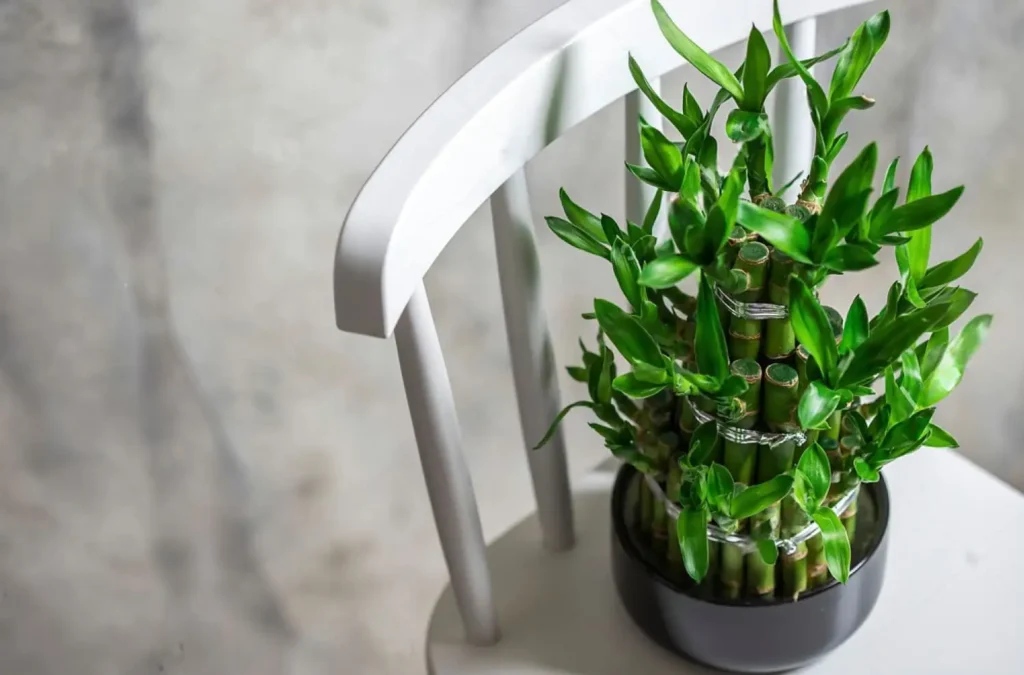
Pests & Diseases: Vigilance Against Threats
Caring for your Lucky Bamboo goes beyond providing water and sunlight; it involves protecting it from potential pests and diseases. Being vigilant and proactive is key to maintaining the health and vibrancy of your plant. Here’s a comprehensive guide to understanding and managing pests and diseases that may affect your Lucky Bamboo.
Common Pests
1. Spider Mites:
Spider mites are tiny arachnids that can infest Lucky Bamboo, causing stippling and webbing. To control them:
- Use insecticidal soap or neem oil.
- Regularly wipe the leaves with a damp cloth to remove mites.
2. Scale Insects:
Scale insects appear as small, waxy bumps on stems and leaves. They can harm your plant by feeding on sap. Combat scale insects by:
- Scrubbing the scales off with a soft brush.
- Applying neem oil to control infestations.
3. Aphids:
Aphids are small, soft-bodied insects that cluster on new growth, sucking sap and causing yellowing. Manage aphids by:
- Spraying a solution of soapy water or neem oil.
- Introducing natural predators like ladybugs.
Fungal Issues
1. Root Rot:
Overwatering can lead to root rot, a fungal disease that affects the roots and stems. Prevent and address root rot by:
- Allowing the top inch of soil to dry out before watering.
- Ensuring the pot has proper drainage.
2. Leaf Spot:
Leaf spot manifests as dark spots on leaves, often caused by fungal infections. Combat leaf spot by:
- Pruning affected leaves to reduce the spread.
- Applying a fungicide to manage severe cases.
3. Mold Growth:
Excessive moisture can lead to mold growth on the soil surface. Control mold growth by:
- Improving ventilation around the plant.
- Allowing the top layer of soil to dry between waterings.
Prevention Tips
- Inspect Regularly: Regularly inspect your Lucky Bamboo for any signs of pests or diseases. Early detection allows for prompt intervention.
- Isolate Infected Plants: If you notice pests or diseases on one plant, isolate it from others to prevent the issue from spreading.
- Maintain Good Hygiene: Keep the area around your Lucky Bamboo clean. Remove fallen leaves and debris, as they can harbor pests and fungi.
- Provide Proper Ventilation: Good air circulation helps prevent fungal issues. Ensure that your plant is not placed in a stagnant, humid environment.
- Use Natural Predators: Introduce natural predators like ladybugs or predatory mites to control pest populations organically.
Remember that prevention is often more effective than cure when it comes to pest and disease management. By following these guidelines and staying vigilant, you can ensure that your Lucky Bamboo remains healthy and thriving.
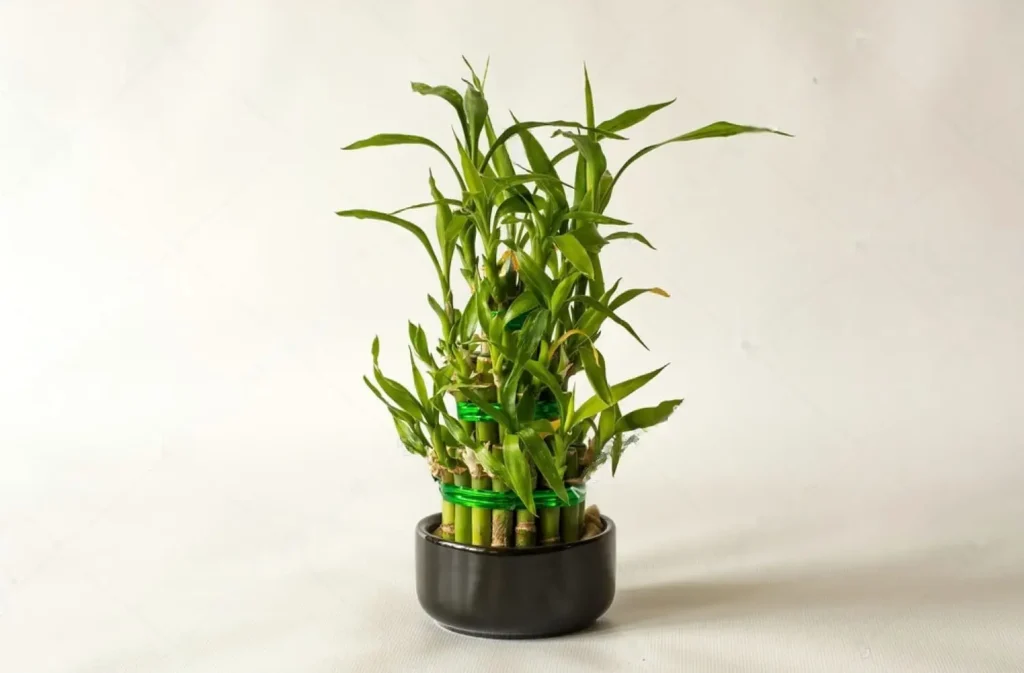
Common Problems: Troubleshooting Woes
Even the most seasoned plant enthusiasts encounter challenges with Lucky Bamboo. Understanding and addressing common problems promptly is crucial for the health and vitality of your cherished plant. Here’s a guide to troubleshooting some of the frequent issues:
1. Yellowing Leaves:
Cause: Yellowing leaves often indicate either overwatering or inadequate light.
Solution:
- Adjust Watering: Allow the top inch of soil to dry out between waterings. Ensure the plant is not sitting in standing water.
- Increase Light Exposure: Lucky Bamboo prefers indirect sunlight. If the leaves are pale, consider providing more filtered sunlight.
2. Mold Growth:
Cause: Excessive moisture in the environment can lead to mold growth on the soil surface.
Solution:
- Improve Ventilation: Increase air circulation around the plant by placing it in a well-ventilated area.
- Reduce Watering: Allow the soil to dry out slightly between waterings to prevent mold development.
3. Wilting Stalks:
Cause: Wilting stalks are a clear sign of underwatering.
Solution:
- Increase Watering: Ensure that the soil remains consistently moist, but not waterlogged.
- Check Soil Moisture: Stick your finger into the soil. If it feels dry, it’s time to water.
4. Stalk Discoloration:
Cause: Discoloration, such as browning or yellowing of stalks, can be a result of various factors.
Solution:
- Review Watering Practices: Ensure you’re following proper watering guidelines, avoiding both overwatering and underwatering.
- Examine Light Conditions: Check if the plant is receiving adequate but indirect sunlight. Adjust the placement accordingly.
5. Root Rot:
Cause: Overwatering and waterlogged soil create conditions favorable for root rot.
Solution:
- Adjust Watering: Allow the top layer of soil to dry before the next watering.
- Improve Drainage: Ensure that the pot has drainage holes, and the soil mix is well-draining.
6. Leaf Curling:
Cause: Leaf curling can be a response to environmental stress, typically caused by inconsistent watering or extreme temperature fluctuations.
Solution:
- Maintain Consistent Conditions: Keep the temperature and watering routine consistent to avoid stress.
- Observe for Pests: Check for pests like spider mites, as they can also cause leaf curling.
7. Bamboo Mites:
Cause: Spider mites can infest Lucky Bamboo, causing stippling, discoloration, and webbing.
Solution:
- Insecticidal Soap: Use insecticidal soap or neem oil to control mite infestations.
- Isolation: If the infestation is severe, isolate the affected plant to prevent the mites from spreading.
8. Fungal Issues:
Cause: Fungal problems can arise from overly moist conditions, especially in poorly ventilated areas.
Solution:
- Improve Ventilation: Increase air circulation around the plant to discourage fungal growth.
- Modify Watering: Adjust your watering routine to avoid water stagnation in the soil.
By identifying and addressing these common problems promptly, you’ll ensure that your Lucky Bamboo continues to thrive, bringing joy and positive energy into your living space.
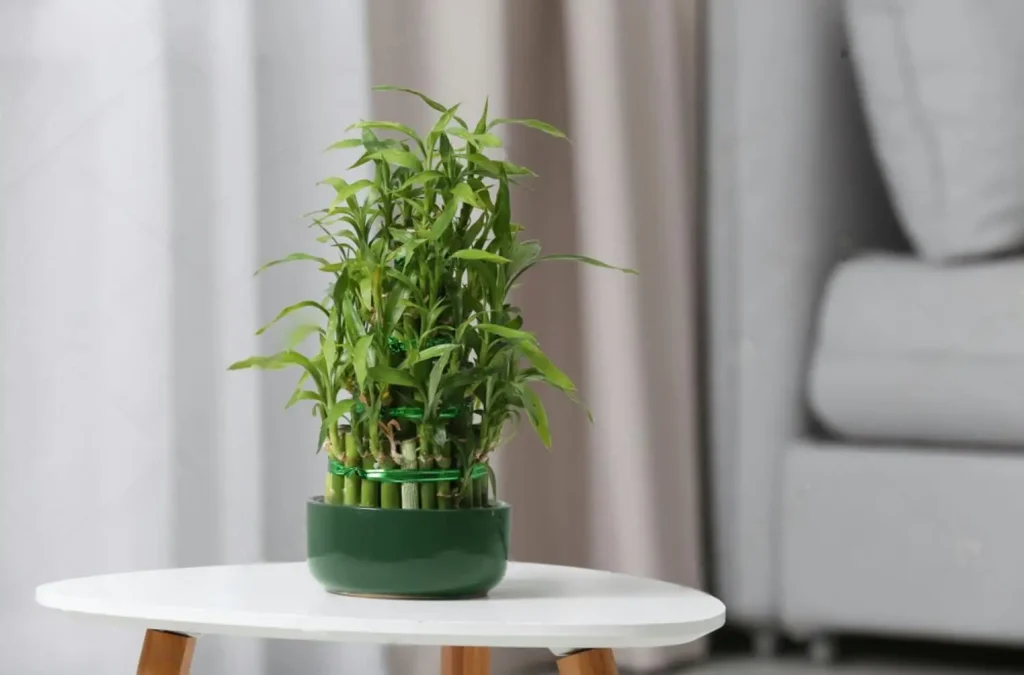
FAQs: Frequently Asked Questions
How often should I water Lucky Bamboo?
Proper watering is crucial for Lucky Bamboo’s health. Water sparingly, allowing the top inch of soil to dry out between waterings. Overwatering can lead to root rot, so it’s essential to strike a balance. Aim for slightly damp soil without waterlogging the roots.
Can Lucky Bamboo survive in low light conditions?
Lucky Bamboo is known for its adaptability, making it suitable for low light conditions. However, to ensure optimal growth and vibrancy, it’s advisable to provide some filtered sunlight. While it can tolerate low light, introducing indirect sunlight contributes to its overall well-being.
How do I propagate Lucky Bamboo?
Propagating Lucky Bamboo is a rewarding process. Begin by selecting healthy stalks with at least one node. Using clean, sharp scissors, cut the stalk at a 45-degree angle. Trim excess leaves and roots. Place the cut end in a vase with distilled or filtered water, changing it weekly. Once the roots are 2-3 inches long, carefully transplant the new shoot into well-draining soil.
When should I repot Lucky Bamboo?
Repotting is essential for Lucky Bamboo’s growth. Consider repotting every two years or when the plant outgrows its current container. Choose a pot with drainage holes, ensuring it’s approximately 2 inches larger in diameter than the current one. Follow the potting procedure to provide fresh, nutrient-rich soil for sustained growth, minimizing root disturbance.
How do I prevent pests and diseases in Lucky Bamboo?
Protecting Lucky Bamboo from pests and diseases requires vigilance. Common pests like spider mites, scale, and aphids can be managed with insecticidal soap or neem oil. Regularly inspect the plant for any signs of infestation. Additionally, ensure proper drainage to prevent fungal issues, as Lucky Bamboo is susceptible to root rot if the soil remains consistently moist. Proper care, including maintaining a clean environment and addressing issues promptly, is key to preventing these problems.
Read Me – Manjula Pothos: The Ultimate Care And Growing Guide

